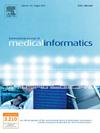Artificial intelligence based predictive tools for identifying type 2 diabetes patients at high risk of treatment Non-adherence: A systematic review
IF 3.7
2区 医学
Q2 COMPUTER SCIENCE, INFORMATION SYSTEMS
International Journal of Medical Informatics
Pub Date : 2025-03-01
DOI:10.1016/j.ijmedinf.2025.105858
引用次数: 0
Abstract
Aims
Several Artificial Intelligence (AI) based predictive tools have been developed to predict non-adherence among patients with type 2 diabetes (T2D). Hence, this study aimed to describe and evaluate the methodological quality of AI based predictive tools for identifying T2D patients at high risk of treatment non-adherence.
Methods
A systematic search was conducted across multiple databases including, EMBASE, Cochrane Library, MedLine, and Google Scholar search. The Prediction model Risk Of Bias ASsessment Tool (PROBAST) was used to assess the quality of studies. The performances of tools were assessed by Area Under the Curve (AUC), precision, recall, C-index, accuracy, sensitivity, specificity or F1 score.
Results
Most studies measured predictive ability using AUC (75 %), and some only reported precision (25 %), recall (12.5 %), C-index (12.5 %), accuracy (37.5), sensitivity (12.5 %), specificity (12.5 %) or F1 score (25 %). All tools had moderate to high predictive ability (AUC > 0.70). However, only one study conducted external validation. Demographic characteristics, HbA1c, glucose monitoring data, and treatment details were typical factors used in developing tools.
Conclusions
The existing AI based tools holds significant promise for improving diabetes care. However, future studies should focus on refining the existing tools, validating in other settings, and evaluating the cost-effectiveness of AI-supported interventions.
基于人工智能的预测工具用于识别2型糖尿病患者治疗不依从的高风险:系统回顾
一些基于人工智能(AI)的预测工具已经被开发出来,用于预测2型糖尿病(T2D)患者的不依从性。因此,本研究旨在描述和评估基于人工智能的预测工具的方法学质量,以识别治疗不依从的高风险T2D患者。方法系统检索EMBASE、Cochrane Library、MedLine、谷歌Scholar等数据库。使用预测模型偏倚风险评估工具(PROBAST)评估研究质量。通过曲线下面积(Area Under The Curve, AUC)、精密度、召回率、c指数、准确度、灵敏度、特异性或F1评分来评估工具的性能。结果大多数研究使用AUC(75%)测量预测能力,有些研究仅报告精密度(25%)、召回率(12.5%)、c指数(12.5%)、准确度(37.5)、敏感性(12.5%)、特异性(12.5%)或F1评分(25%)。所有工具均具有中等至高度的预测能力(AUC >;0.70)。然而,只有一项研究进行了外部验证。人口统计学特征、糖化血红蛋白、血糖监测数据和治疗细节是开发工具时使用的典型因素。结论现有的基于人工智能的工具在改善糖尿病护理方面具有重要的前景。然而,未来的研究应侧重于完善现有工具,在其他环境中进行验证,并评估人工智能支持干预措施的成本效益。
本文章由计算机程序翻译,如有差异,请以英文原文为准。
求助全文
约1分钟内获得全文
求助全文
来源期刊

International Journal of Medical Informatics
医学-计算机:信息系统
CiteScore
8.90
自引率
4.10%
发文量
217
审稿时长
42 days
期刊介绍:
International Journal of Medical Informatics provides an international medium for dissemination of original results and interpretative reviews concerning the field of medical informatics. The Journal emphasizes the evaluation of systems in healthcare settings.
The scope of journal covers:
Information systems, including national or international registration systems, hospital information systems, departmental and/or physician''s office systems, document handling systems, electronic medical record systems, standardization, systems integration etc.;
Computer-aided medical decision support systems using heuristic, algorithmic and/or statistical methods as exemplified in decision theory, protocol development, artificial intelligence, etc.
Educational computer based programs pertaining to medical informatics or medicine in general;
Organizational, economic, social, clinical impact, ethical and cost-benefit aspects of IT applications in health care.
 求助内容:
求助内容: 应助结果提醒方式:
应助结果提醒方式:


